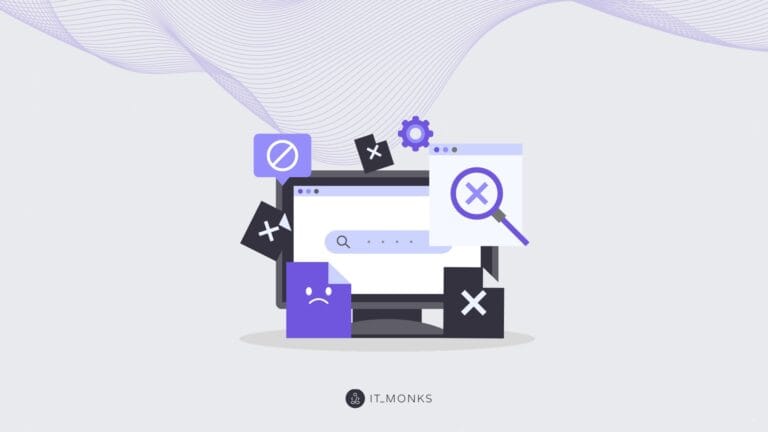Chatbot for Ecommerce Website: Complete Guide
Table of Contents
Table of Contents

Ecommerce has transformed people’s shopping, offering unparalleled convenience, a vast selection of products, and the ability to shop anywhere anytime. Over the past decade, ecommerce has seen exponential growth, driven by the increasing adoption of smartphones, improved internet connectivity, and changing consumer behaviors. As the ecommerce landscape evolves, businesses are under constant pressure to stay competitive in a crowded market. To succeed, companies must offer high-quality products and provide exceptional customer experiences. This is where innovative technologies like a chatbot for an ecommerce website come into play.
What is a Chatbot?
A chatbot is a software application that uses artificial intelligence (AI) and natural language processing (NLP) to understand and respond to human language. Chatbots are programmed to simulate conversations with users through text or voice. The concept of chatbots has been around for decades, with one of the earliest examples being ELIZA, a program developed in the 1960s by Joseph Weizenbaum. ELIZA was designed to mimic a psychotherapist by responding to user inputs to encourage further conversation.
Over the years, chatbot usage has evolved significantly thanks to AI, machine learning, and NLP advancements. Modern chatbots are far more sophisticated than their predecessors, capable of handling complex interactions and providing personalized responses based on user data. They have become powerful tools in various industries, mainly ecommerce, where they help businesses automate customer support, improve customer retention, and drive sales.
Types of Chatbots
Chatbots can be categorized into two main types, each offering different levels of functionality:
- Rule-Based Chatbots: These chatbots operate based on a set of predefined rules or scripts. They are typically used for handling simple, straightforward tasks, such as answering frequently asked questions or guiding users through a specific process. Rule-based chatbots follow a linear flow and can only respond to specific inputs. While they are easy to implement and cost-effective, their limitations become apparent when users deviate from the expected inputs, leading to a breakdown in communication.
- AI-Driven Chatbots: Also known as smart chatbots, these are powered by artificial intelligence and machine learning. Unlike rule-based chatbots, AI-driven chatbots can learn from user interactions and improve over time. They use NLP to understand and interpret user inputs, allowing them to engage in more natural, dynamic conversations. AI-driven chatbots can handle various queries, making them ideal for providing personalized customer support, offering product recommendations, and performing other complex tasks in ecommerce.
Eager to boost web store’s usability?
How Chatbots Work in the Context of Ecommerce
In ecommerce, chatbots are designed to enhance the customer experience by providing instant assistance throughout the shopping journey. Here’s how they typically work:
- Customer Interaction: A chatbot of an ecommerce website may initiate a conversation by offering assistance or responding to a query. This interaction can occur via text or voice depending on the chatbot’s capabilities.
- Understanding User Intent: The chatbot uses NLP and machine learning to analyze the user’s input and understand their intent. This involves identifying keywords, interpreting the context, and determining the appropriate response.
- Providing Relevant Responses: The chatbot retrieves information from its database or connects with other systems to provide a relevant response based on the user’s input. This could include answering questions, offering product suggestions, processing orders, or providing order tracking information.
- Personalization: AI-driven chatbots can use data such as past interactions, purchase history, and browsing behavior to personalize their responses. For example, they might recommend products based on the customer’s previous purchases or preferences.
- Continuous Improvement: AI-driven chatbots learn from each interaction over time, improving accuracy and effectiveness. They can adapt to new situations, refine their responses, and provide users with a more seamless and intuitive experience.
Chatbots are becoming an integral part of the ecommerce experience, offering businesses a way to engage with customers more effectively, reduce response times, and ultimately increase customer satisfaction and loyalty. By automating routine tasks and providing personalized support, chatbots free up human agents to focus on more complex issues, driving greater efficiency and enhancing the overall customer journey.
Benefits of Chatbots in Ecommerce

As ecommerce continues to evolve, businesses are constantly seeking ways to enhance the customer experience, streamline operations, and drive sales. Chatbots have emerged as a powerful tool in this regard, offering a range of benefits that can significantly impact the success of an online store. By automating various aspects of customer interaction and operations, chatbots improve efficiency and provide valuable insights to help businesses better understand and cater to their customers. Below are some of the key benefits of a chatbot in ecommerce.
Enhanced Customer Support
One of the most significant advantages of the chatbot usage in ecommerce is the ability to provide enhanced customer support. Unlike human agents, chatbots are available 24/7, ensuring customers can receive assistance anytime, day or night. This around-the-clock availability is crucial in today’s fast-paced, global marketplace, where customers may shop from different time zones and expect immediate responses.
A customer support chatbot for ecommerce can handle many customer inquiries, from answering frequently asked questions (FAQs) to providing detailed product information. They are programmed to respond quickly, reducing wait times and improving customer satisfaction. Whether it’s helping a customer find a specific product, checking the status of an order, or guiding them through the checkout process, chatbots are equipped to provide instant, accurate assistance. This level of support enhances the customer experience and frees up human agents to focus on more complex issues, further improving the efficiency of customer service operations.
Increased Sales and Conversion Rates
Chatbots drive sales and increase conversion rates by offering personalized shopping experiences. AI-driven technology allows chatbots to analyze customer behavior, preferences, and past purchases to tailor product recommendations. This level of personalization helps create a more engaging and relevant shopping experience, encouraging customers to purchase.
In addition to personalized recommendations, chatbots are also effective tools for upselling and cross-selling. Chatbots can increase the average order value and boost overall sales by suggesting complementary products or upgrades during shopping. For example, if a customer purchases a smartphone, the chatbot might suggest accessories like a protective case or a screen protector. These subtle nudges can lead to additional purchases that the customer may not have considered otherwise, ultimately driving higher revenue for the business.
Need to optimize store for conversions?
Streamlined Operations
Beyond customer support and sales, chatbots streamline various operational tasks within an ecommerce business. For instance, chatbots can manage order tracking and provide real-time updates to customers about the status of their orders. This keeps customers informed and reduces the number of inquiries that human agents need to handle, allowing them to focus on more pressing matters.
Chatbots are also instrumental in handling returns and refunds, guiding customers through the process easily. By automating these tasks, businesses can ensure that these processes are handled efficiently and consistently, reducing the likelihood of errors and improving overall operational efficiency. Additionally, chatbots can handle multiple tasks simultaneously, allowing businesses to manage higher volumes of customer interactions without compromising on service quality.
Data Collection and Customer Insights
One of the most valuable aspects of using chatbots in ecommerce is their ability to collect and analyze customer data. Every interaction with a chatbot provides insights into customer preferences, shopping behaviors, and pain points. This data can be aggregated and analyzed to identify trends, understand customer needs, and make informed business decisions.
For example, chatbots can gather customer feedback about their shopping experience, helping businesses identify areas for improvement. They can also track which products are frequently inquired about or purchased together, providing insights into potential cross-selling opportunities. Chatbots can help businesses optimize their marketing strategies, product offerings, and customer engagement by analyzing shopping behaviors.
Key Features of an Ecommerce Chatbot

For an ecommerce chatbot to be effective, it must possess an ecommerce feature that enhances its functionality, improves user interactions, and ensures the security of customer data. These features determine the chatbot’s ability to serve customers efficiently and integrate into the broader ecommerce ecosystem. Below are the essential features that every ecommerce chatbot should have.
Personalization
Personalization is one of the most critical features of an ecommerce chatbot, as it significantly enhances the customer experience. A personalized chatbot tailors its responses based on user data, such as past interactions, purchase history, browsing behavior, and preferences. This allows the chatbot to offer highly relevant product recommendations, promotions, and assistance to the user.
For example, if a customer frequently purchases skincare products, the chatbot might recommend new arrivals in that category or offer a discount on a related product. Using data to personalize interactions, chatbots can create a more engaging and enjoyable shopping experience, leading to higher customer satisfaction and increased sales. Personalization also helps build stronger customer relationships, as users feel understood and valued by the brand.
Seeking enjoyable shopping experience?
Integration with Ecommerce Platforms
Seamless integration with ecommerce platforms is another essential feature of a successful chatbot. The chatbot must be compatible with popular ecommerce platforms such as Shopify, WooCommerce, Magento, and others, allowing it to access product catalogs, manage orders, and interact with various backend systems.
Integration with these platforms ensures that the chatbot can provide accurate and up-to-date information to customers, such as product availability, pricing, and shipping options. It also allows the chatbot to assist with order processing, track shipments, and handle returns directly within the ecommerce platform. By being fully integrated, the chatbot becomes an integral part of the ecommerce ecosystem, streamlining operations and enhancing the overall customer experience.
Multichannel Support
Customers interact with brands across multiple channels, including social media, websites, and mobile apps. A key feature of an ecommerce chatbot is its ability to provide consistent support across all these channels, ensuring that customers receive the same level of service regardless of where they engage with the brand.
Multichannel support means the chatbot can be deployed on various platforms, such as Facebook Messenger, WhatsApp, Instagram, and a brand’s website or mobile app. This allows businesses to meet customers wherever they are, providing instant assistance and seamless interactions. For example, a customer might start an inquiry on social media and continue the conversation on the website, with the chatbot maintaining context and continuity. This omnichannel approach enhances convenience and ensures a unified brand experience across all touchpoints.
Natural Language Processing (NLP)
Natural Language Processing (NLP) is the technology that enables chatbots to understand and respond to human language naturally and intuitively. NLP allows the chatbot to interpret user inputs, recognize intent, and generate appropriate responses, making interactions feel more human-like and less robotic.
Chatbots can handle many customer queries with NLP, even when phrased differently. For instance, a customer might ask, “What’s the status of my order?” or “Where is my package?”—NLP enables the chatbot to recognize both questions about order tracking and provide the correct information. This capability is crucial for creating a positive user experience, as customers expect chatbots to understand and respond to their inquiries accurately and efficiently.
Advanced NLP also allows chatbots to engage in more complex conversations, understand context, and provide nuanced responses. This makes the interaction more interactive and satisfying for the user, as the chatbot can handle follow-up questions, clarify information, and offer detailed assistance.
Security and Privacy
As chatbots interact with customers and handle sensitive information, such as personal details and payment data, ensuring ecommerce site security and privacy is paramount. A robust ecommerce chatbot must have strong security features to protect customer data from unauthorized access, breaches, and other cyber threats.
Need to keep your store safe?
Security measures should include data encryption in transit and at rest, secure authentication methods, and compliance with relevant data protection regulations, such as GDPR or CCPA. Additionally, the chatbot should be designed to minimize the collection of sensitive information and to handle data in a way that respects user privacy.
Customers are increasingly concerned about how their data is used and stored, and a chatbot that prioritizes security and privacy can help build trust with users. By ensuring that customer data is handled securely, businesses can protect their reputation and reduce the risk of data breaches, which can have severe financial and legal consequences.
Steps for Implementing a Chatbot to an Ecommerce Website

Integrating a chatbot into your ecommerce website can significantly enhance customer service, streamline operations, and boost sales. However, successful implementation requires careful planning and execution. From selecting the right platform to designing the chatbot experience, each step must be thoughtfully considered to ensure that the chatbot meets your business goals and delivers a seamless user experience. Below, we outline the key steps in adding a chatbot to an ecommerce website.
Choosing the Right Chatbot Platform
The first step in implementing a chatbot is choosing the right platform. Several factors should be considered when making this decision, as the platform you select will impact the chatbot’s functionality, scalability, and overall effectiveness.
- Cost: The cost of chatbot platforms can vary widely, depending on the features and level of customization offered. Evaluating your budget and considering upfront costs and ongoing expenses, such as subscription fees, maintenance, and potential upgrades, is important.
- Features: Different platforms offer varying levels of sophistication in AI capabilities, natural language processing (NLP), integration with ecommerce platforms, and customization options. Identify the most important features of your business and ensure the platform supports them.
- Scalability: As your business grows, your chatbot should be able to scale with it. Consider whether the platform can handle increasing volumes of customer interactions, support additional languages, and integrate with other systems as your business needs evolve.
By carefully considering these factors, you can select a chatbot platform that aligns with your business requirements and provides the foundation for a successful implementation.
Designing the Chatbot Experience
Once you’ve chosen a platform, the next step is to design the chatbot experience. This involves mapping out user journeys and determining how the chatbot will interact with customers at various stages of their shopping experience.
- User Journeys: Start by identifying the key touchpoints where the chatbot will engage with users, such as when they first visit the website, browse products, or need assistance during checkout. Map out the potential paths users might take and design the chatbot’s responses accordingly. This helps ensure the chatbot provides relevant and timely assistance, guiding users smoothly through their journey.
- Conversation Flows: Designing effective conversation flows is crucial for creating a seamless user experience. Consider how the chatbot will handle different types of inquiries, from simple FAQs to more complex customer service issues. The goal is to make interactions intuitive and user-friendly, minimizing the need for users to repeat themselves or navigate through unnecessary steps.
- Tone and Personality: The chatbot’s tone and personality should align with your brand’s voice. Whether it’s formal, friendly, or playful, consistency in communication style helps create a cohesive brand experience.
By carefully designing the chatbot experience, you can ensure that it meets your customers’ needs while enhancing their overall interaction with your website.
Training the Chatbot
Training the chatbot is critical in the implementation process, particularly if using an AI-driven platform. This involves teaching the chatbot to understand and respond accurately to various user inputs.
- AI and Machine Learning: Use an AI chatbot for ecommerce typically involves feeding the chatbot with large datasets of customer interactions, including various ways users might phrase questions or requests. The chatbot uses this data to improve its ability to recognize patterns, interpret intent, and generate appropriate responses.
- Continuous Learning: AI-driven chatbots can learn from each interaction, gradually improving their accuracy and effectiveness. It’s important to regularly update the chatbot’s training data to reflect new products, promotions, or changes in customer behavior.
- Testing Responses: As part of the training process, test the chatbot’s responses to ensure they are accurate and relevant. This may involve running simulated conversations or using real customer interactions to refine the chatbot’s performance.
Testing and Optimization
Thorough testing is essential before launching the chatbot to identify and address any potential issues. This step helps ensure that the chatbot functions smoothly and meets user expectations.
- Beta Testing: Start by conducting beta testing with a small group of users. This allows you to observe how real customers interact with the chatbot and gather feedback on its performance. Pay attention to areas where the chatbot may struggle to understand or respond correctly.
- Continuous Improvement: Based on the feedback from beta testing, make necessary adjustments to the chatbot’s conversation flows, responses, and functionalities. Optimization should be ongoing, with regular updates and improvements based on user feedback and performance data.
- Monitoring Performance: After the chatbot is live, its performance is continuously monitored using analytics tools. Track key metrics such as response times, user satisfaction, and conversion rates to assess the chatbot’s effectiveness and identify areas for further improvement.
Challenges and Considerations
Implementing a chatbot is not without its challenges. It’s essential to be aware of potential issues and take proactive steps to address them.
- Implementation Issues: Integrating a chatbot with your existing ecommerce platform can sometimes be complex, particularly if you have an extensive or customized website. Ensure that your IT team is involved early in the process to troubleshoot any technical challenges that may arise.
- Balancing Automation with Human Touch: While chatbots can handle many tasks, there are times when human intervention is necessary, particularly for complex or sensitive customer service issues. Striking the right balance between automation and the human touch is key to maintaining customer satisfaction.
- Regulatory Compliance and Data Privacy: Compliance with data protection regulations, such as GDPR or CCPA, is crucial when implementing a chatbot. Ensure that the chatbot is designed to handle customer data securely and adheres to all relevant privacy laws. This includes providing clear information about how customer data will be used and stored and offering options for users to manage their data preferences.
Future Trends in Ecommerce Chatbots

As technology advances, ecommerce chatbots are poised to become even more integral to the online shopping experience. The future of chatbots will be shaped by several key trends, particularly advancements in artificial intelligence (AI) and the integration of augmented reality (AR) into the shopping journey. These innovations will not only enhance the capabilities of chatbots but also redefine how customers interact with ecommerce platforms.
AI Advancements and How They Will Shape the Future of Chatbots
Artificial intelligence is at the heart of modern chatbots, enabling them to understand and respond to customer queries increasingly sophisticatedly. As AI technology continues to evolve, we can expect significant improvements in the capabilities of an AI chatbot for ecommerce.
- Natural Language Processing (NLP) Evolution: Future chatbots will benefit from more advanced NLP algorithms, allowing them to understand and interpret complex language better, including slang, regional dialects, and even emotions conveyed through text. This will make interactions more natural and intuitive, bridging the gap between human and machine communication.
- Personalization at Scale: AI-driven chatbots will become even more adept at delivering personalized experiences. With the ability to analyze vast amounts of data in real-time, chatbots will provide highly tailored recommendations, offers, and support based on individual customer profiles. This level of personalization will drive higher engagement and conversion rates, making the shopping experience more relevant and satisfying for each customer.
- Predictive Analytics: The future of ecommerce chatbots will also see the integration of predictive analytics, enabling chatbots to anticipate customer needs and preferences before they even express them. By analyzing past behavior and current trends, chatbots can proactively suggest products, provide assistance, or offer promotions, enhancing the customer journey and increasing sales opportunities.
- Voice-Activated Shopping: As voice recognition technology improves, chatbots will increasingly support voice-activated shopping. This trend will allow customers to interact with chatbots through spoken commands, making shopping more accessible and convenient, especially for mobile users.
Integration with Augmented Reality (AR) Shopping Experiences
Integrating augmented reality (AR) into ecommerce is another exciting trend that will significantly impact the role of chatbots. AR allows customers to visualize products in their real-world environment before purchasing, providing a more immersive and informed shopping experience.
- Virtual Try-Ons: One of the most promising applications of AR in ecommerce is virtual try-ons, where customers can see how clothing, accessories, or makeup will look on them without leaving their homes. Chatbots integrated with AR technology will guide customers through these virtual experiences, offering personalized recommendations based on the customer’s style preferences and past purchases.
- Product Visualization: For products like furniture or home decor, AR allows customers to visualize how items will fit in their space. Shopping chatbots can assist by answering questions, suggesting complementary products, and providing detailed information about each item, all while the customer views the product in their home environment through AR.
- Interactive Shopping Assistance: As AR becomes more prevalent, shopping chatbots help customers navigate AR experiences, offering suggestions based on what they see, and even guiding them to complete the purchase seamlessly within the AR interface. This integration will create a more engaging and dynamic shopping experience, making ecommerce more similar to in-person shopping than ever before.
Conclusion
As AI technology advances and augmented reality becomes more integrated into the shopping experience, the role of chatbots in ecommerce will only grow more significant. These innovations will improve chatbots’ capabilities and transform how customers engage with ecommerce platforms, making online shopping more personalized, interactive, and intuitive.
For businesses looking to stay competitive in the rapidly evolving ecommerce landscape, investing in chatbot technology and staying ahead of these trends will be crucial. Using a chatbot for an ecommerce website, businesses can provide exceptional customer experiences, drive higher conversion rates, and maintain a strong presence in the digital marketplace.
Need help expert help with setting up and managing your ecommerce website? Contact the IT Monks team for professional ecommerce website development and maintenance services. We know how to make every ecommerce store perform to its fullest potential.




